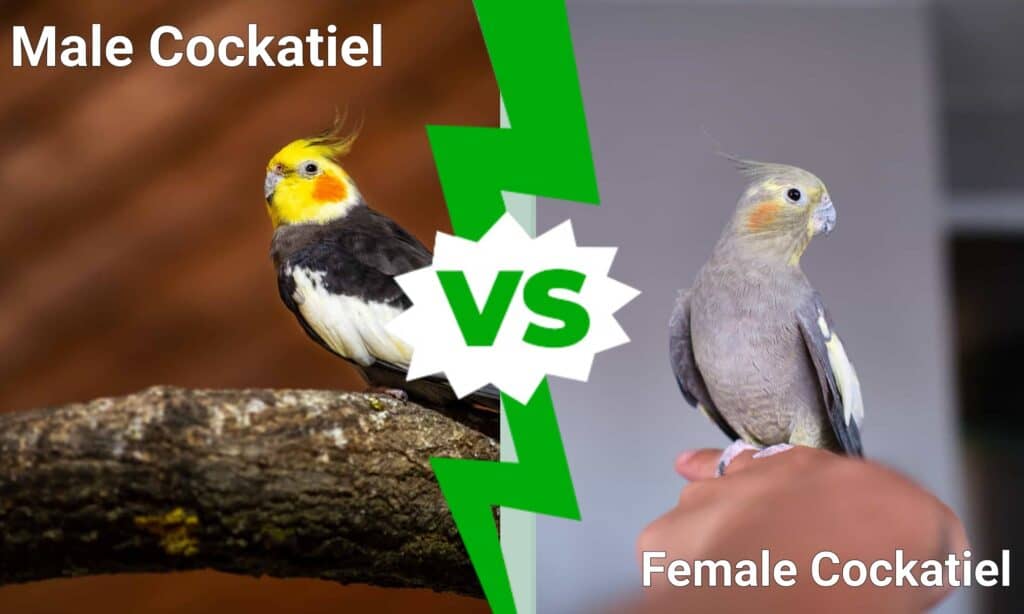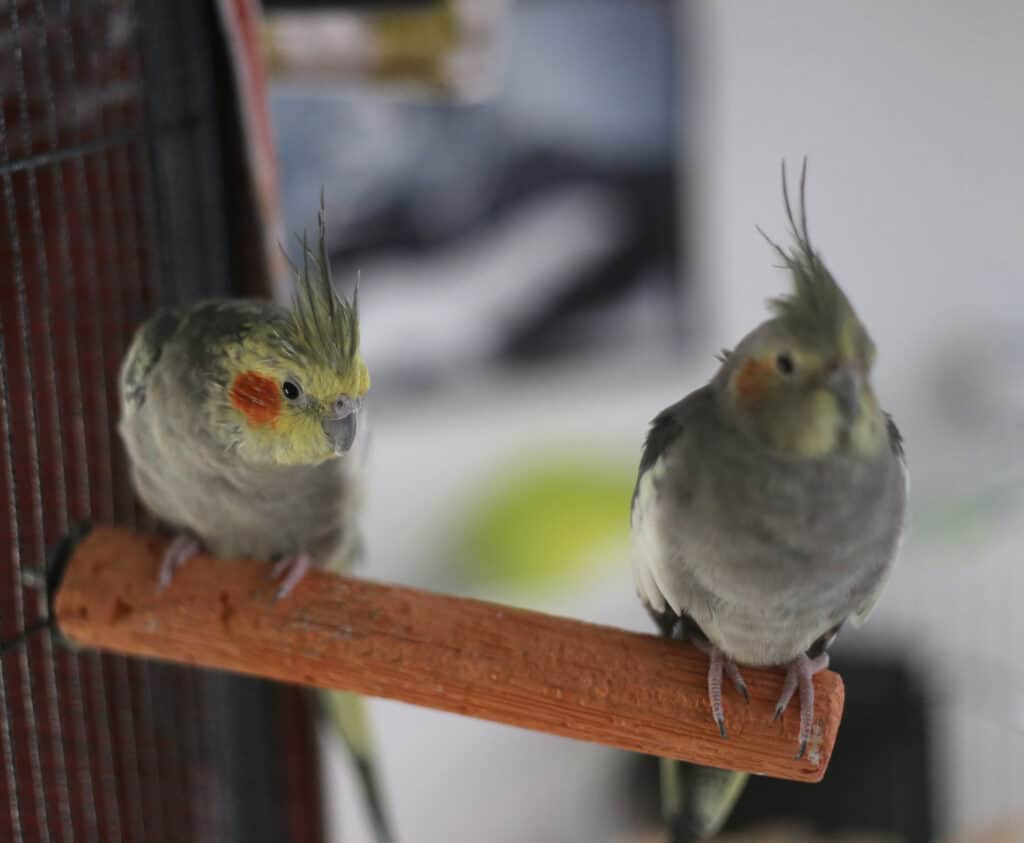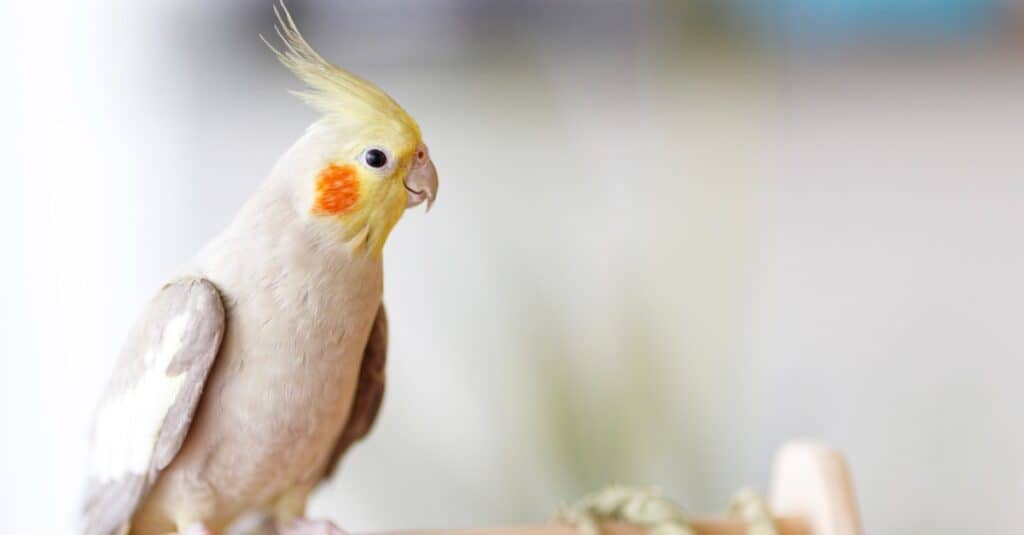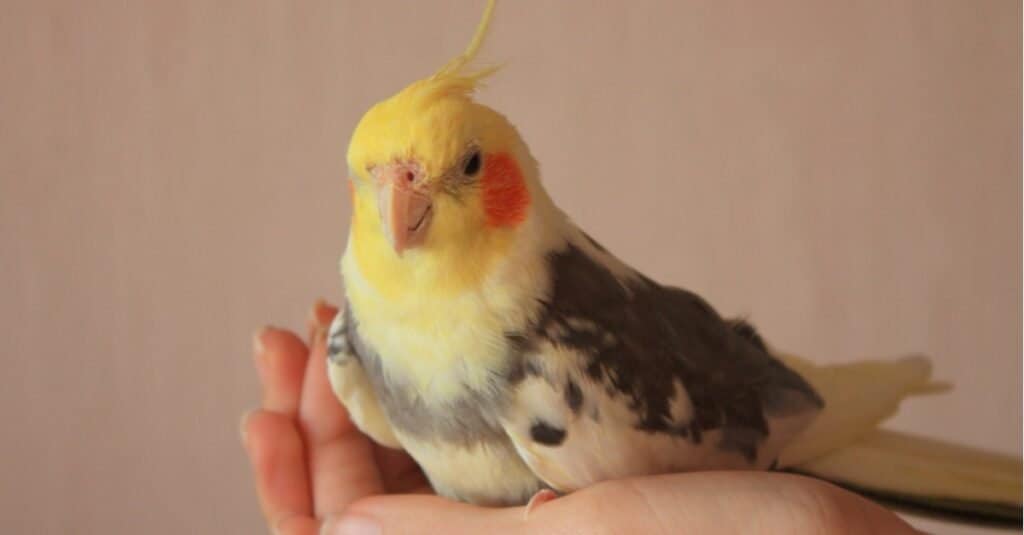Cockatiels are a type of small parrot that are native to the dry, non-coastal regions of Australia. They are extremely common to keep as pets and are well-loved for their charming and interactive personalities. If you’d like to know the sex of your cockatiel you can bring it in to a veterinarian for an exam. A professional can likely determine whether you have a male or female based on pelvic anatomy, but a DNA test is the most reliable method. However, there are a variety of physical and behavioral traits that can clue you in to the sex of the bird you are trying to identify. So let’s take a look at the male vs female cockatiel and discover the main differences between the sexes when it comes to these “cheddar-cheeked” cockatoos.
Comparing a Male and Female Cockatiel

| Male Cockatiel | Female Cockatiel | |
| Size | 12-14 in, 2.5-4.2 oz, as adults | 12-14 in, 2.5-4.2 oz, as adults |
| Morphology | Darker colored body plumage, yellow face, vibrant cheek spots | Lighter body plumage, brown or gray face, muted cheek spots, markings beneath tail feathers |
| Behavior | Active, curious, investigate potential threats | Reserved, shy, flee from potential threats |
| Vocalization | More expressive, more likely to sing and speak human words | Quieter, tend to use a sharp “wheep” whistle most often |
Key Differences Between a Male and Female Cockatiel
The key male vs female cockatiel differences include their morphology, behavior and vocalizations. They will often display slightly different plumage that you can learn to recognize. Behaviors and vocalizations will be unique to individual birds, however, there are some trends that can definitely help to determine the sex of your cockatiel.
Read on to discover whether males or females have brighter “cheddar cheeks,” who is more curious and who prefers to observe from a distance. We will also discuss vocalization so that you can guess whether its the male or female cockatiel you’ll hear carrying a tune!
Male vs Female Cockatiel: Morphology

Male cockatiels tend to display more prominent cheek plumage than female cockatiels.
©iStock.com/jojoo64
Wild cockatiels and the most popular pet varieties are gray bodied with white, orange and yellow accents. However, many color variations exist in the pet market including lutino, cinnamon, fallow, silver, yellow cheek, pearl and more. Lutino breeds are a popular mutation of the common cockatiel that are pale yellow or white white with the typical bright orange cheek circles. A female of the Lutino variety will display yellow spots under her wings and yellow markings under her tail. If you need to identify the sex of a cockatiel with unusual plumage you may have to rely on behavioral traits.
It is hard to determine the sex of young cockatiels as they don’t show sexually dimorphic traits until adulthood. At 6 to 9 months they will molt for the first time and develop a new coat of plumage. These new feathers usually show greater variation between the sexes. It can sometimes take several moltings for full, vibrant adult plumage to present.
In gray cockatiel breeds, males are usually darker overall than females, but this is not always a reliable indicator of sex. The male will also usually show more striking facial features. He will have vivid orange cheek spots set on his bright yellow face. Males develop their yellow face after molting, while females may maintain the gray or brownish face of a young cockatiel. Females will typically show lighter orange spots on a thier muted yellow, brownish or gray face. They have markings beneath their tail feathers. These are typically horizontal stripes that alternate between gray and dark gray, white and gray, or yellow and gray. Some may have dots or other patterns on a gray background. If no markings are present on the undersides of the tail feathers, the bird is likely a male.
Male vs Female Cockatiel: Behavior

Males display more curiosity and confidence, while female cockatiels are quieter and more reserved.
©iStock.com/bee32
Courtship rituals are one of the behavioral traits to observe when you want to distinguish between a male and female cockatiel. You may notice that male cockatiels actively court females and that they may display courtship behaviors even without any other birds around. One of these behaviors includes tapping his beak on objects in order to gain a female’s attention. A male may also strutt about while beak tapping or whistling with hopping and possibly quick head dips. They will sometimes carry their wing tips away from their body. This appears as a heart shape when seen from behind, how romantic!
While females are usually less active before bonding or mating with a partner, they may display some characteristic signs of readiness to mate. A female ready to find a mate may sit low on a perch peeping quietly with her tail in the air. You might also see her feeding the male that she’s bonded with or is working on establishing a connection to.
In general, female cockatiels tend to be more reserved and will tend to retreat or draw away from commotion, while males may move towards and investigate. Females tend to observe and flee rather than charge towards a potential threat.
Male vs Female Cockatiel: Vocalizations

Females tend to vocalize less than males, who are more likely to sing melodies and speak human phrases.
©iStock.com/sapozhnik
While male and female cockatiels tend to express different vocalizations, this is more of a trend than a rule. Cockatiels tend not to have a vocabulary that develops to the extent of other types of parrots, but they can be taught to say ‘hello’, and learn to speak many other human words or phrases. They can also be taught to sing specific melodies. They may imitate environments or human voices without ever being taught to do so.
Male cockatiels are more likely than females to express themselves with this type of vocalization. They tend to be more vocal in general and seem to enjoy whistling. Female cockatiels are typically quieter and will oven hiss and screech more often than males. They have a sharp “wheep” whistling sound that they use most often. This is usually used in response to a familiar human voice or to respond to other cockatiels.
The photo featured at the top of this post is © iStock.com/Vronja_Photon
Thank you for reading! Have some feedback for us? Contact the AZ Animals editorial team.






